Showing posts by Julien Katchinoff.
-
Green Objections to the Green Line: A Struggle for a Shared Environment in the Middle East
›March 4, 2010 // By Julien KatchinoffAn emerging coalition in Israel dramatically illustrates how common environmental concerns can create unexpected partnerships across difficult political barriers. Through programs initiated by Friends of the Earth Middle East, the Israeli and Palestinian residents of Wadi Fukin and Tzur Hassadah (see inset map) have joined together to oppose the construction of a planned security barrier between their two communities.
View Good Water Neighbors in a larger map
The barrier, an element of the Israeli Green Line, threatens to disrupt karstic springs that support traditional agriculture in the Fukin valley. One third of the Israeli residents of Tzur Hadassah petitioned to halt construction, reports Israeli newspaper Haaretz.
“The Israeli community understood that instead of providing them with security, the fence would harm the springs and lands of the village, and will rob the Palestinian farmers of their livelihood and arouse hatred toward their Israeli neighbors,” Friends of the Earth Middle East (FoEME) Director Gidon Bromberg told Haaretz.
On February 24th, Israelis and Palestinians from both communities met to organize their response to the construction of the separation barrier, including preparing to petition to the Israeli High Court of Justice.
“The case of Wadi Fukin is special, because it is the first time that the resistance of the residents is not based on human rights allegations. Objections here are from an environmental organization,” FoEME attorney Michael Sfard told NRG news. Since 2001, FoEME’s Good Water Neighbors project has helped divided communities come together over shared natural resources. By collaborating with community members to improve their water situation, the organization encourages sustainable water management through information sharing, dialogue, and cooperative ventures. While the majority of the communities share common surface water sources, including the Jordan and Zomar rivers, some, as with Wadi Fukin and Tzur Hassadah, rely on common underground aquifers.
Since 2001, FoEME’s Good Water Neighbors project has helped divided communities come together over shared natural resources. By collaborating with community members to improve their water situation, the organization encourages sustainable water management through information sharing, dialogue, and cooperative ventures. While the majority of the communities share common surface water sources, including the Jordan and Zomar rivers, some, as with Wadi Fukin and Tzur Hassadah, rely on common underground aquifers.
This “natural interdependence,” says Bromberg, helps to create trust and solve problems facing both communities.
Photo: Courtesy Friends of the Earth Middle East -
Monitoring Resources and Conflict
›
Is the “resource curse” inevitable? The Resource Conflict Monitor (RCM) produced by the Bonn International Center for Conversion (BICC) attempts to monitor the management, administration, and governance of natural resources in countries prone to resource-conflict dynamics by establishing an empirical measure of resource governance.
-
VIDEO – Ken Conca: Future Faces of Water Conflict
›February 24, 2010 // By Julien Katchinoff“Most of the actual violence around water today is not occurring with armies marching out on the field of battle…[it] is more diffuse, more at the community level, more small scale, but quite real and quite important for us to try to address,” says Ken Conca, professor of government and politics at the University of Maryland during this conversation with ESCP Director Geoff Dabelko. Though the world remains fixated on future “water wars,” we “should not forget the actually existing violence in the world today,” he says.
Conca underscores the need to address the multiple forms of violence around water. Factors that incite these conflicts include lax consultation with local communities over large infrastructure projects as well as changes in access to water due to economic or environmental dynamics.
Conca suggests new principles that promote water as a global human right future may be part of the solution to these drivers of conflict. Such conflicts may be avoided by broadening the current conversation, allowing for new approaches to infrastructure development, and applying techniques of effective dispute resolution, particularly at the international level. -
Peace Through Parks on Israel’s Borders – Dream or Reality?
›In areas fraught with conflict, is it possible to advance conflict resolution through environmental discourse? A recent conference hosted by Tel Aviv University’s Porter School of Environmental Studies explored this question through an examination of existing peace parks, as well as possible future preserves.
The wide-ranging discussion sought to apply theories of conflict resolution and environmental peacemaking to local conflict in the Middle East. Touching on conservation, conflict resolution, local history, geography, ecology, and diplomacy, the participants underscored the importance of restoration efforts, local environmental maintenance, and the pursuit of peace through environmental cooperation.
For more, watch these presentations on YouTube (in English; with Timestamps):
Event Part One:
0:15:50
“Conservation to Conflict Resolution: Understanding the Theory and Practice of Peace Parks”
Dr. Saleem Ali, Rubenstein School of Environment and Natural Resources, University of Vermont
1:36:28
“Peace Parks on Israel’s Borders: Lessons from South Sinai”
Dr. Dan Rabinowitz, Department of Sociology and Anthropology, Tel Aviv University
1:55:49
“The Jordan River Peace Park: Post-conflict environmental peacebuilding between Israel and Jordan”
Gidon Bromberg, Israeli Director, Friends of the Earth Middle East
Event Part Two:
0:01:12
“The Golan Heights – A critical habitat with global significance”
Dr. Tamar Ron, Ecologist, biodiversity conservation consultant
2:11:01
Session Response:
Valerie Brachya, Director, Environmental Policy Center Jerusalem Institute for Israel Studies
Photo: Golan Heights Panorama, Courtesy Flickr User Vad_Levin. -
Collier and Birdsall: Plunder or Peace
›January 22, 2010 // By Julien Katchinoff In a preview of his new book The Plundered Planet: Why We Must – and How We Can – Manage Nature for Global Prosperity, Paul Collier dispelled the common perception that Africa’s indentified resource reserves are the world’s largest. In actuality, it is estimated that up to four-fifths of the value of subsoil assets in the African continent are yet to be discovered. “That is the big story,” Collier remarked. “Here are assets which could finance transformation….but historically haven’t.” Instead, these resources have been plundered.
In a preview of his new book The Plundered Planet: Why We Must – and How We Can – Manage Nature for Global Prosperity, Paul Collier dispelled the common perception that Africa’s indentified resource reserves are the world’s largest. In actuality, it is estimated that up to four-fifths of the value of subsoil assets in the African continent are yet to be discovered. “That is the big story,” Collier remarked. “Here are assets which could finance transformation….but historically haven’t.” Instead, these resources have been plundered.
In a recent event hosted by the U.S. Institute of Peace, Paul Collier, professor of economics and director of the Center for the Study of African Economies at Oxford University, and Nancy Birdsall, president of the Center for Global Development, discussed how resource-rich environments in developing countries have been traditionally misused. The two also proposed strategies to disrupt these processes and transform resource “curses” into deeply needed support for peace and stable development.
Conflict and instability in countries whose economies are heavily invested in natural resource have often hindered local development and security. Many of these countries—including Cambodia, Angola, Indonesia, and DRC—have suffered from one of two forms of plunder:
Types of Natural Resources Plunder:
1. Where the few steal from the many:
Natural assets are, by definition, without natural owners, and therefore lie as easily taken common goods. “This process of expropriation opens up a whole array of dysfunctional variants, many of which are violent,” Collier noted.
2. Where the present steals from the future:
Intertemporal mismanagement is a possibility, as unlike man-made assets, natural assets belong to all generations.
Operating from a worldview of weak sustainability, where profits from natural assets are reinvested for the benefit of future generations, Collier suggested that natural resource rights are more akin to “rights of stewardship” than traditional property rights. “We may well transform that value into something that is more productive, but if we pull up natural assets from the ground, we should leave to the future something that is equivalently valuable.”
Collier argued that the successful harnessing of natural resources for stable and sustainable development depends on the application of a tenuous decision chain:
Natural Resources Decision Chain:
1. Discovery Process:
Failure in this phase stems from poor property rights, and the time consistency problem—uncertainty that conditions and regulations that make expensive upfront investments profitable today will remain in place in the future.
2. Appropriate Taxation:
Currently, as a result of poor negotiations or limited information regarding the status of resources, governments are unable to craft tax regimes which effectively capture resource rent.
3. Avoiding the Delta:
Sustainable management any discovered subsoil assets must avoid a local “Nigerian Delta” catastrophe. Clearly designating the government as the sole responsible agent for resource rents may limit such failures.
4. Saving the money:
To avoid plunder of the future by the present, Collier suggested that, though politically difficult, a proportion of revenue streams must be delineated from general accounts.
5. Building the capacity to invest in the country:
Collier deemed the inability of resource-rich countries to attract diversified investment as the “killer link.” Governments must use returns from subsoil assets to fund “investment in investment”—directing public capital toward transportation and utility infrastructure, education, health, and other short-term projects. Once in place, such projects encourage future public and private investments, thereby multiplying long-term returns.
As with many complex systems, Collier warned that the chain is only as strong as its weakest link. If one link fails, “the chain won’t pull the country from poverty to prosperity.” On the other hand, if each link holds, the value is tremendous. ”[Y]ou really can pull the country from poverty to prosperity over the course of a generation. There are no fixes in economics that are faster than that.”
Ultimately, Collier and Birdsall emphasized that success depends upon the development of an informed and competent “critical mass” of people. Even the strongest decision chain will fail if it is not underwritten by a majority of the population. Birdsall reiterated the need for public participation in the process, possibly through direct income distribution or responsible interventions by non-vested third parties.
Photo: Courtesy of Oxford University Press. -
Water, Conflict, and Cooperation: Practical Concerns for Water Development Projects
› “Water disputes that can start at the local level—little things—have the potential, in extreme cases, to burgeon into something much bigger,” warned Ken Hackett, president of Catholic Relief Services (CRS), during a discussion at the Woodrow Wilson Center (Webcast) for the launch of CRS’ new publication, Water and Conflict: Incorporating Peacebuilding into Water Development. The report provides guidance to water development practitioners, civil society members, and others striving to incorporate water and peacebuilding into their project frameworks.
“Water disputes that can start at the local level—little things—have the potential, in extreme cases, to burgeon into something much bigger,” warned Ken Hackett, president of Catholic Relief Services (CRS), during a discussion at the Woodrow Wilson Center (Webcast) for the launch of CRS’ new publication, Water and Conflict: Incorporating Peacebuilding into Water Development. The report provides guidance to water development practitioners, civil society members, and others striving to incorporate water and peacebuilding into their project frameworks.
In recognition of water’s potential to drive conflict, Hackett—part of a panel featuring Jason Gehrig, Water and Conflict‘s primary author; William Hall, professor of conflict resolution at Georgetown University; and Tjip Walker, team leader of USAID’s conflict management and mitigation office‘s warning and analysis unit—urged those working on water to focus attention on identifying and diffusing areas of emerging disagreement while they are still manageable. “We must, in a proactive way, incorporate peacebuilding methodologies in water and sanitation work,” said Hackett.
Looking Beyond Tubes and Tanks Prior to witnessing violent protests within the Altiplano region of Bolivia, Jason Gehrig assumed that the primary obstacles to successful water development efforts would be found in the technical phase of designing or building delivery systems. Local political developments, however, demonstrated that “we can’t just be looking at development without also looking at the structural issues at play,” said Gherig.
Prior to witnessing violent protests within the Altiplano region of Bolivia, Jason Gehrig assumed that the primary obstacles to successful water development efforts would be found in the technical phase of designing or building delivery systems. Local political developments, however, demonstrated that “we can’t just be looking at development without also looking at the structural issues at play,” said Gherig.
Emphasis on “social infrastructure” and the inclusion of peacebuilding paradigms allows for conflict transformation and the mitigation of future violence through heightened conflict sensitivity by local practitioners. Such understanding and sensitivity to local conflicts and structures, Gehrig asserted, can only be achieved by “listening, winning hearts and minds (beginning with our own) by getting close to the people so that their struggle for life, for dignity, for peace, becomes our own.”
Defining the Role of Environmental Conflict Resolution William Hall noted that conflict sensitive practices apply several elements of environmental conflict resolution (ECR), such as in-depth social participation, context analysis, stakeholder involvement, and the use of neutral parties.
William Hall noted that conflict sensitive practices apply several elements of environmental conflict resolution (ECR), such as in-depth social participation, context analysis, stakeholder involvement, and the use of neutral parties.
For Hall, the goal of ECR is not only conflict resolution, but “also how people will be involved.” Adapting a framework design from the International Association for Public Participation, Hall reminded the audience that decision-makers must clearly communicate both the goals of their intervention as well as the degree of public involvement required and desired. These issues are sensitive; Hall emphasized that, once a commitment has been made, it is extremely important “to be true to [one’s promises.]”
In situations such as those included in the CRS report, successful peacebuilding efforts—which result in high-quality agreements and improved working relationships between the affected parties—must include effective engagement of appropriate stakeholders, proper mediation, and high-quality information. While many of these factors may be seen as additional procedural complications and expenses, Hall countered that recent research has shown that, compared to standard methods, agreements reached within an ECR context grant economic and environmental benefits beyond those afforded by alternative processes.
Peacefully Managing the Commons Tjip Walker noted that effective governance of water and other common pool resources, often magnets for mismanagement and contention, should be a pivotal concern for peacebuilders in fragile states. Drawing on research on governance and conflict, Walker explained that countries that are more democratic, and allow for greater social participation, are at a lower risk for violent conflict.
Tjip Walker noted that effective governance of water and other common pool resources, often magnets for mismanagement and contention, should be a pivotal concern for peacebuilders in fragile states. Drawing on research on governance and conflict, Walker explained that countries that are more democratic, and allow for greater social participation, are at a lower risk for violent conflict.
With regard to threats posed by common pool resources, Walker reminded the forum that Elinor Ostrom’s work demonstrates it is possible—providing a “enabling environment” for governance—to manage such resources without exposure to dire consequences. In many cases, however, Ostrom’s requirements for sustainable management are unfortunately difficult to achieve and are further complicated by pre-existing challenges stemming from economic dependencies and political arrangements.
Referring to previous trans-boundary river conflict projects, Walker noted that “most of them have been positive…[which] seems to suggest that we are all in this together.” Successes such as these grant hope for the future, yet also demonstrate a need for negotiated agreements across political boundaries. “Under the right circumstances,” Walker concluded, “we do have the ability to manage these resources effectively in ways that are perceived as generally being effective and legitimate.”
For more information about water, conflict and cooperation, as well as other events and publications under ECSP’s Navigating Peace Initiative, please visit www.wilsoncenter.org/water.
Photo: Courtesy David Hawxhurst, Woodrow Wilson Center.


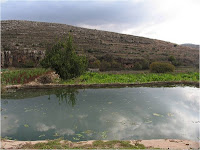 Since 2001, FoEME’s
Since 2001, FoEME’s 

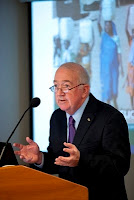 “Water disputes that can start at the local level—little things—have the potential, in extreme cases, to burgeon into something much bigger,” warned Ken Hackett, president of
“Water disputes that can start at the local level—little things—have the potential, in extreme cases, to burgeon into something much bigger,” warned Ken Hackett, president of 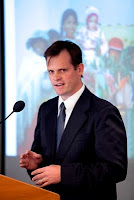 Prior to witnessing violent protests within the Altiplano region of Bolivia, Jason Gehrig assumed that the primary obstacles to successful water development efforts would be found in the technical phase of designing or building delivery systems. Local political developments, however, demonstrated that “we can’t just be looking at development without also looking at the structural issues at play,” said Gherig.
Prior to witnessing violent protests within the Altiplano region of Bolivia, Jason Gehrig assumed that the primary obstacles to successful water development efforts would be found in the technical phase of designing or building delivery systems. Local political developments, however, demonstrated that “we can’t just be looking at development without also looking at the structural issues at play,” said Gherig.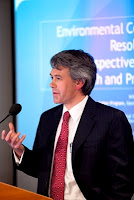 William Hall noted that conflict sensitive practices apply several elements of environmental conflict resolution (
William Hall noted that conflict sensitive practices apply several elements of environmental conflict resolution (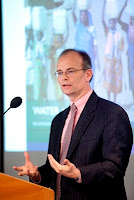 Tjip Walker noted that effective governance of water and other common pool resources, often magnets for mismanagement and contention, should be a pivotal concern for peacebuilders in fragile states. Drawing on research on governance and conflict, Walker explained that countries that are more democratic, and allow for greater social participation, are at a lower risk for violent conflict.
Tjip Walker noted that effective governance of water and other common pool resources, often magnets for mismanagement and contention, should be a pivotal concern for peacebuilders in fragile states. Drawing on research on governance and conflict, Walker explained that countries that are more democratic, and allow for greater social participation, are at a lower risk for violent conflict.

